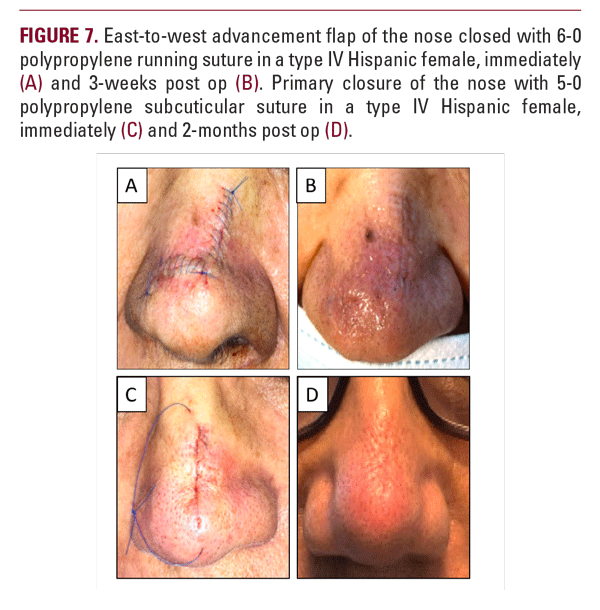

In our hands, we observe a brisk inflammatory reaction following the placement of poliglecaprone-25 as an epidermal suture (Figure 6). While inconsequential in patients with skin types (I to III), we observe post-operative PIH in FST V and FST VI patients. Thus, we avoid poliglecaprone 25 as an epidermal suture in these patients. While clinical studies are needed, in vivo studies exist that support our observation. Riberio and colleagues report higher tissue reactions when poliglecaprone-25 is used as an external suture compared to its use as an internal suture.17 Similarly, an in vivo study by Filho and colleagues found a mild inflammatory reaction within 48 hours of poliglecaprone implantation. This was not observed following polyglactin 910 implantations.18 While Rosenzweig and colleagues report equal cosmetic outcomes with 5-0 poliglecaprone-25 and 6-0 polypropylene, skin type was not reported. Neither was there mention of the presence of absence post-operative erythema or pigmentation.16
Poliglecaprone’s absorption time should be considered when used as an epidermal suture in skin of color. The absorption time of poliglecaprone is up 119 days in contrast with 35 days for fast absorbing gut. As discussed above, prolonged suture implantation stimulates a brisk inflammatory reaction even in non-absorbable sutures and may result in PIH in patients with skin of color.
We emphasize that the widely accepted categorization of poliglecaprone as having “low reactivity” is relative to other absorbable subcutaneous sutures and based on studies performed in rat muscle, not epidermis.15 Nylon has much lower tissue reactivity compared to poliglecaprone 25.17 Comparative in vivo studies show that poliglecaprone induces an inflammatory reaction mediated by neutrophils and macrophages, in contrast to largely the acellular reactions to nylon.15
Based on our experience and evidence in the literature reviewed above, non-absorbable sutures are superior choices for epidermal sutures in patients with skin of color (Figure 7). Sutures should be removed promptly (ie, 5 to 7 days on the face and 10 to 14 days on the trunk and extremities) to avoid delayed suture reactions. Table 2 presents suture types in order of increasing tissue reactivity based on published literature to provide an algorithmic guide to suture selection in skin of color.11,12,17,19
Suture diameter also warrants consideration. The degree of tissue damage caused by sutures is directly proportional to the suture diameter (assuming closely matched and appropriate needle size) and inversely proportional to the coefficient of friction.20 Few reports that 6-0 nylon leaves virtually no track marks in skin of color.21 To further reduce track marks, a running subcuticular suture with polypropylene is preferred to a simple running whenever possible.
Non-Suture Alternatives in Skin of Color
Tissue adhesives octyl cyanoacrylate (Dermabond®) and surgical strips in combination with liquid adhesive (Mastisol®) are safe and effective in patients with skin of color (Figure 8). We have not observed increased rates PIH with the use of these non-suture alternatives, especially in the setting of fastidious wound care and adherence to post-operative instructions. We instruct patients with non-suture alternatives to “let them flake off on their own.” Pre-mature forceful removal of non-suture alternatives produce epidermal trauma and PIH.
Scar Revision and Laser Resurfacing in Skin of Color
Scar revision should be considered in patients with skin of color who experience suboptimal aesthetic outcomes.22 We safely






